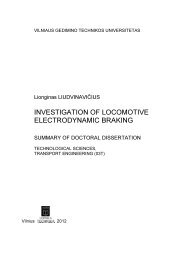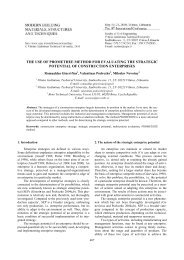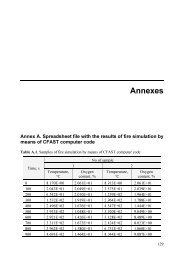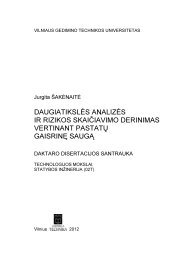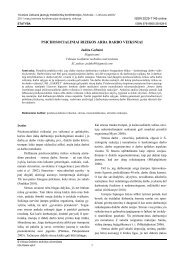ENVIRONMENTAL ENGINEERING
ENVIRONMENTAL ENGINEERING
ENVIRONMENTAL ENGINEERING
You also want an ePaper? Increase the reach of your titles
YUMPU automatically turns print PDFs into web optimized ePapers that Google loves.
<strong>ENVIRONMENTAL</strong><br />
<strong>ENGINEERING</strong><br />
May 22-23, 2008<br />
The 7 th International Conference<br />
Faculty of Environmental Engineering<br />
Vilnius Gediminas Technical University<br />
Saulėtekio ave 11, LT-10223 Vilnius, Lithuania<br />
Phone: +370 5 2745090; Fax.: +370 5 2744731; e-mail: ap2008@ap.vgtu.lt<br />
CALIBRATION OF CODED LEVELLING STAFFS<br />
Vytautas Giniotis, Donatas Rekus, Ceslovas Aksamitauskas<br />
Department of Geodesy and Cadastre, Vilnius Gediminas technical university,<br />
Saulėtekio al. 11, LT-10223 Vilnius, Lithuania,<br />
e-mail: gkk@ap.vgtu.lt<br />
Abstract. Digital levels are a precise instruments used for precise leveling. Operation of digital levels is based on the<br />
digital processing of video indications of a coded staff. Changes in leveling methodology and sources of specific<br />
errors occur using digital levels for precise levelling. The marks on the leveling meters also are modified and consist<br />
from the coded strokes put on the meter’s surface in specific order. The accuracy of performance of all the measuring<br />
equipment mostly depends on accuracy of position of those strokes. This paper deals with an analysis of an accuracy<br />
calibration of leveling meters<br />
Keywords: coded staff, digital levelel, leveling error, accuracy, calibration.<br />
1. Introduction<br />
Changes in leveling methodology and sources of<br />
specific errors occurs using digital levels for precise<br />
levelling. Precision investigations of a particular model of<br />
levels and coded staffs and digital levelling are necessary.<br />
Operation of levelling instruments is based on the digital<br />
processing of image of the coded meter. Every company<br />
producing the leveling instruments has developed its own<br />
codes and methods of their processing: correlation<br />
(LeicaWild NA2000/2002/3000/3003 systems),<br />
geometric method (Zeiss DiNi 10/20 systems), phase<br />
method (Topcon DL – 101/102 systems) [1-6].<br />
At the beginning of measurement a visual pointing<br />
of the instrument into the surface of leveling meter is<br />
performed. After that the instrument automatically points<br />
the focus of its optical system on the surface of the meter<br />
and then a rough correlation calculation is performed<br />
followed by the precise correlation. According to data<br />
received in the processor of the instrument an exact<br />
distance from the axes of the instrument to the surface of<br />
the level mete is calculated. According to the information<br />
received by decoding it from the photoelectric matrix the<br />
height of the level placing is calculated in the processor.<br />
During this operation the coded view of the meter is<br />
compared with that saved in the memory of the<br />
instrument. A true meter’s height position is determined<br />
according to the shift of the image in the photoelectric<br />
sensor (pixels) matrix.<br />
1310<br />
Processing of information is quite complicated in<br />
various leveling systems. For example, in Leica systems<br />
the code bars (strokes) are put on the all length – 4050<br />
mm of the meter. The bar code has 2000 elements, each<br />
of them having 2,025 mm in width. It is evident, that the<br />
production of such meter is quite complicate; its accuracy<br />
mostly depends on the errors of placement of the coded<br />
bars. The matrix of the photodiodes (pixels) has 256<br />
elements placed with the pitch of 25 µm from each other.<br />
Accuracy of placement of these cells also has an<br />
influence on the overall accuracy of the instrument’s<br />
performance.<br />
An accuracy of the calibration of placement of the<br />
coded bars on the surface of the meters is analyzed in this<br />
paper.<br />
2. Calibration of the coded staffs<br />
The system calibration can be used to determine the<br />
correction values of rod readings and hence the scale of the<br />
digital leveling system, secondly to examine its behavior<br />
and thirdly, to estimate the accuracy.<br />
During the last decades the geodetic instruments<br />
have become more automatic and electronic, fine<br />
constructed and externally well operating systems. The<br />
software has replaced more and more observer’s task.<br />
Also the levelling experienced the similar development:<br />
The discovery of the digital levelling in the beginning of<br />
the 90’s really conduced the levelling into the new era. [12,<br />
13]
In old times the levelling instruments were simply<br />
constructed, but they were also manufactured in great care<br />
applying precision mechanics. So, we users knew more<br />
and understand better the function of the leveling<br />
instruments and in most cases, we were able to quickly<br />
locate the functional faults and to correct small<br />
imperfections. When we operate with a digital levelling<br />
system, a CCD camera takes picture from the rod, which<br />
covers a certain sector of the bar code scale above and<br />
below the horizontal level. The picture is then compared to<br />
the picture of the whole scale stored in the memory of the<br />
instrument. Each manufacturer has its own method to<br />
process the rod reading [1, 2]. In a digital level the rod<br />
readings are automatically processed applying electrooptical<br />
technique, while in conventional levelling the<br />
observer manually gets a rod reading using the optical<br />
tools of the instrument, e.g., line of sight, hair cross,<br />
ocular, micrometer, line of level etc. A CCD camera<br />
replaces the human eye. In processing a rod reading the<br />
digital levelling employs more than just one code line.<br />
In conventional levelling the scale is based on the<br />
scale of a rod, while in digital levelling we can speak<br />
about two scales: Scale of an instrument and scale of a rod.<br />
The digital level gives the former, but in fact the scale of<br />
level is expected to be equal with the scale of rod.<br />
However, with time, the scale of level can be changed e.g.<br />
by aging of the CCD sensor. Also the scale of level is<br />
sensitive for scratches of code elements or shadows on<br />
invar band etc.<br />
All coded meters can be calibrated by use of the<br />
interferometric comparators. Usually it is enough to<br />
measure every stroke (or bar) of 2.025 mm width at the<br />
pitch determined. The gaps between the bars are at the<br />
distances in times of 2.025 mm. Vertical comparators are<br />
mostly used for this purpose. By horizontal comparators<br />
the thermal expansion coefficients and thermal resistance<br />
of the meter are investigated. The meters are calibrated at<br />
0, 10, 20, 30 and 40 0 C of temperature.<br />
The comparators partly repeat the operations of<br />
leveling. (Fig.1)<br />
Fig. 1. The FGI system calibration in the FGI laboratory<br />
Some of the height leveling can be used for<br />
measurement or calibration of precision leveling meters.<br />
Usually the vertical position of the calibration is used<br />
having the purpose to keep the same position as it is<br />
during the working operations. Nevertheless, there are<br />
variants of calibration in the horizontal position as it<br />
1311<br />
saves the height of the calibration laboratory and makes<br />
an operation easier. The vertical comparators are arranged<br />
in Graz University of Technology (Austria), at Institute of<br />
Geodesy (Finland), Munich Bundeswer University,<br />
Germany. Horizontal structure of the comparator is<br />
applied in ETH University, Zurich.<br />
In the system calibration the rod is set on the vertical<br />
conveyor controlled by laser interferometer and the digital<br />
level at a certain distance from the rod as illustrated in Fig.<br />
2. The rod is moved step by step in vertical direction and<br />
the rod readings are observed with the instrument during<br />
the stop between the steps. The readings are taken from<br />
different sectors of the bar code rod and then compared<br />
with true values obtained by the laser interferometer. [9]<br />
Fig.2 Especially designed for the Zeiss DiNi12 digital<br />
levelling system with two observation pillars.<br />
3. Photogrametric calibration<br />
Principles of photogrammetry can be used for the<br />
comparing the views of the etalon and meter to be<br />
calibrated. The correlation factor determination can be<br />
used successfully as well as in the case of Digital leveling<br />
operation. The etalon view is save din the PC memory,<br />
and the view of tested meter must be extracted from the<br />
CCD camera. All the measurements are performed in the<br />
PC screen using analyzing gap covering the both images<br />
(Fig. 3 and 4).<br />
At first, adjustments of the meters views in the<br />
direction of x and y axes must be taken. As it is seen in<br />
Fig. 1, badi mage projection causes the faults in the<br />
images, not horizontal alignment result in the cosine error<br />
to be present at the misalignment angle ϑ. It is evident<br />
that the true length h of the image will differ from the<br />
misaligned length l as ∆ l = l(1 − lcos ϑ)<br />
.<br />
The meters have an opportunity to be shifted along<br />
each other on the computer screen. CCD camera is<br />
supplied by the analyzing window for the selection the<br />
part of the meters that are selected for the comparison<br />
between themselves [7-11]. The analyzing window is<br />
shifted along the length of the meters or replaced by steps<br />
at least three times – at the beginning, in the middle and<br />
at the end of the meters. In this case it is easier to apply<br />
zooming process for the part taken in step measurement.
It would be impossible in such view as it is shown in Fig.<br />
1.<br />
The readings are taken by using the standard<br />
software AutoCad. The readings are shown only as an<br />
example without any statistical processing. According to<br />
the rexample it can be stated that the accuracy of<br />
measurement by this method can reach tens of microns in<br />
average.<br />
2<br />
1<br />
- 0,2 0 0,2 0,4 0,6 3<br />
ϑ<br />
y<br />
x<br />
Fig. 3. General view of photogrametric calibration of leveling<br />
meters: 1 etalon meter, 2 meter to be calibrated, 3<br />
linear and vernier scale for readings, 4 moving reticle<br />
An accurate comparing of the meters can be<br />
accomplished by the correlation method. A better case to<br />
apply this is comparison of the same type of the meters,<br />
for example, both coded meters by the same producer.<br />
The signals from the photoelectric sensors (pixels) is<br />
output to the PC making an array of numerical values<br />
from the both meters at the same position. It coincides<br />
with the known area-based method described in [11]. The<br />
difference is only in the aim of its applying. In our case it<br />
is the comparison of the position of edges of the bars on<br />
the tested meter. The processing of the images goes in the<br />
same way as according to the method above. Smaller<br />
subarrays from the both arrays are taken and the<br />
correlation factor is calculated using the formula [11]:<br />
r<br />
m<br />
n<br />
∑∑<br />
4<br />
[( A − A)( B −B)]<br />
ij<br />
ij<br />
i= 1 j=<br />
1<br />
=<br />
1/ 2<br />
⎧ m n m n<br />
⎪ ⎡<br />
2 ⎤⎡<br />
2 ⎤⎫<br />
⎪<br />
⎨⎢∑∑( Aij<br />
− A) ⎥⎢∑∑( Bij<br />
−B)<br />
⎥⎬<br />
i= 1 j= 1 i= 1 j=<br />
1<br />
⎪⎩⎣ ⎦⎣ ⎦⎪⎭<br />
r – correlation coefficient; m and n – numbers of rows and<br />
columns; A ij – digital number from subarray A in the row<br />
i and in the column j; A - average of all digital numbers<br />
in subarray A, and B - average of all digital numbers in<br />
subarray B. i = 0, 1, 2, 3,…, m; j = 0, 1, 2, 3,…, n.<br />
It is evident that a total array of numbers<br />
representing position of the bars on the surface of the<br />
levels will be received from the array of sensors of the<br />
CCD camera converting voltage output into the digital<br />
form. General diagram of photosensors (pixels) with the<br />
view of the coded bar of shown in<br />
1 2 3<br />
ooooooooooooooooooooooo<br />
oooo<br />
ooooooooooooooooooooooo<br />
oooo<br />
ooooooooooooooooooooooo<br />
oooo<br />
ooooooooooooooooooooooo<br />
oooo<br />
ooooooooooooooooooooooo<br />
Fig. 4. Array of photosensors and the bars of the meter on it: 1 –<br />
coded bars of the meter, 2 array of CCD sensors, 3<br />
analyzing window<br />
⎡a11 a12 a13 a14<br />
...<br />
⎢<br />
⎢<br />
a21 a22 a23 a24<br />
...<br />
⎢a31 a32 a33 a34<br />
...<br />
A = ⎢<br />
⎢a41 a42 a43 a41<br />
...<br />
⎢<br />
a51 a52 a53 a54<br />
...<br />
⎢<br />
⎢⎣<br />
... ... ... ... ...<br />
⎡b11 b12 b13 b14<br />
... ⎤<br />
⎢<br />
⎥<br />
⎢<br />
b21 b22 b23 b24<br />
...<br />
⎥<br />
⎢b31 b32 b33 b34<br />
... ⎥<br />
B = ⎢<br />
⎥<br />
⎢b41 b42 b43 b41<br />
... ⎥<br />
⎢<br />
b51 b52 b53 b54<br />
...<br />
⎥<br />
⎢<br />
⎥<br />
⎢⎣<br />
... ... ... ... ... ⎥⎦<br />
Fig. 5. Digital output from the search array of photosensors and<br />
the analyzing window for subarrays selection<br />
A digital output from the photosensors presented in<br />
the form of matrixes A and B, from the view of etalon<br />
meter and calibrated meter respectively, are shown in Fig.<br />
3.<br />
The correlation coefficient is calculated from the<br />
subarrays selected by analyzing window. The error of the<br />
displacement (difference between the position of bars on<br />
the meters) is determined by the local correlation<br />
coefficient. Such operations are performed for this<br />
process:<br />
• preliminary correlation coefficient calculation at<br />
the beginning, middle and the end part of the<br />
meters using the formula (1);<br />
• shift of the subarray B at the predetermined pitch<br />
∆ t and repeating an operation as described<br />
above;<br />
• repeating the first two operations in the<br />
investigation region ± k∆ t , where k = 1, 2, 3, ...<br />
⎤<br />
⎥<br />
⎥<br />
⎥<br />
⎥<br />
⎥<br />
⎥<br />
⎥<br />
⎥⎦<br />
1312
covering the zone of expected error of the<br />
meter‘s bars placement;<br />
• statistical processing of the results of correlation<br />
coefficient calculations determining the position<br />
in the discrete numbers of pitches ∆ t in the<br />
length x of the meter.<br />
More exact evaluation of edges of the bars can be<br />
performed by using the feature-based digital image<br />
assessment technique. In case of a blur image of the<br />
meters additional statistical means must be taken for<br />
determination the position of bars. The values of the<br />
photogrammetric points of the image are assessed by<br />
evaluates of standard deviations Sx;<br />
S<br />
y and<br />
S<br />
xy<br />
( ∑ xi)( ∑ yi)<br />
= x y −<br />
∑ ( , )<br />
. (2)<br />
n<br />
Both coordinates x and y are needed for better<br />
determination of position of the bar’s points as it can be<br />
seen in Fig. 3. Linear regression equation y = α + β x<br />
dx<br />
can be used for this as well, where β =<br />
dy<br />
is the slope<br />
of the line, parameter α is a constant at value x=0. The<br />
same can be determined<br />
Sxy ∑<br />
as ;<br />
yi ∑ xi<br />
β = α = −β<br />
2<br />
Sx<br />
n n .<br />
Accordingly the sample correlation coefficient can<br />
be calculated as<br />
r =<br />
S<br />
xy<br />
2 2<br />
x y<br />
SS<br />
. (3)<br />
Such calculations as it is presented in [11] would be<br />
easier for the determination of the points on the meter‘s<br />
bar edges, and their systematic error will be determined<br />
by changing the pitch ∆ t of subarray sample selection.<br />
Using the analyzing window on the search array of<br />
digital numbers, its position must be changed by steps at<br />
the chosen pitch ∆ t . So a maximal value of correlation<br />
coefficients will be determined at some values i∆ t of the<br />
meter’s length, different from those on the etalon meter.<br />
This difference will be equal to the systematic error of the<br />
bars position at all its length.<br />
3. Conclusions<br />
Preliminary experiments show a possibility to<br />
perform the calibration of leveling meters using the<br />
photogrammetric methods of its comparison. Digital<br />
output array processing using an analyzing window is to<br />
be used. Area based comparison method used in general<br />
purpose photogrammetry can be applied for this purpose<br />
calculating the correlation coefficients at the shift of the<br />
images to each other by the discrete pitch that show the<br />
difference between the position of meter’s bar edges<br />
where maximal values of the correlation coefficient exist.<br />
The systematic error of the meter under the calibration is<br />
determined by the values of position where these<br />
maximal values are found along the total length of the<br />
meter.<br />
References<br />
1. Hilmar Ingensand, “The evolution of digital leveling<br />
techniques – limitations and new solutions”, Geodesy<br />
Surveying in the Future. The Importance of Heights,<br />
Proceedings, Gavle, Sweden, M. Lilje, ed., pp. 59-68,<br />
(1999).<br />
2. NA 2002. NA 3003, “Technical report, digital levels”,<br />
Leica Geosystems AG, Geodesy, CH−9435 Heerbrugg,<br />
(Switzerland), 1997.<br />
3. M. Menzel, “The development of levels during the past 25<br />
years, with special emphasis on the NI002 optical geodetic<br />
level and the DiNi ® 11 digital level”, Geodesy and<br />
surveying in the future. The importance of heights,<br />
Proceedings, M. Lilje, ed., pp. 85-93, (1999).<br />
4. H. Ingensand, A. Meissl, “Digital Levels on the Way to 3-<br />
D Measurements”, Conference on Optical 3-D<br />
Measurement Techniques, Technische Universitat Wien,<br />
(1995).<br />
5. J. Skeivalas, "An accuracy of determination of the<br />
covariation of random values", Geodesy and cartography,<br />
XXV, No 4, pp. 156-158, Vilnius, Technika, (1999).<br />
6. K. T. V. Grattan, J. Skeivalas and V. Giniotis,<br />
“Development of 2D optical measurements”, Proceedings,<br />
pp. 1831-1833, XVII IMEKO World Congress, IMEKO<br />
and HMD, (2003).<br />
7. V.Giniotis, J. Skeivalas, “The level”, Lithuanian Patent LT<br />
4966 B, Int. Cl. G01C 5/02 / Vilnius Gediminas Technical<br />
University, Vilnius: State Patent Office, 10 p., (2002).<br />
8. Manuel Lopez-Alonso, Javier Alda, “Operational<br />
parametrization of the 1/f noise of a sequence of frames by<br />
means of the principal component analysis in focal plane<br />
arrays”, Opt. Eng., 42(7), 1915-1922, (2003).<br />
9. Rüeger, J. M. and F.K. Brunner, 2000. On System<br />
Calibration and Type Testing of Digital Levels. Zeitschrift<br />
für Vermessungswesen 4/2000.<br />
10. M. Takalo and Rouhiainen. On Use of FGI System<br />
Calibration Comparator // Finnish Geodetic Institute, Paris,<br />
France, 2003.<br />
11. Manual of photogrammetry. Fifth edition. Editor J. Chris<br />
McGlone, American Society for and Remote sensing.<br />
12. Woschitz, h., Brunner, f. and Heister, h., 2002a, Scale<br />
Determination of Digital Levelling Systems using a<br />
Vertical Comparator. FIG XXII International Congress<br />
Washington, D.C. USA, April 19-26 2002.<br />
13. Woschitz, H.and Brunner, F., 2002b, System Calibration of<br />
Digital Levels – Experimental Results of Systematic<br />
Effects. Reprint of paper published in: INGEO2002, 2nd<br />
Conference of Engineering Surveying. Kopacik A and<br />
Kyrinovic P (eds) , Bratislava, November 2002: pp 165-<br />
172.<br />
1313



